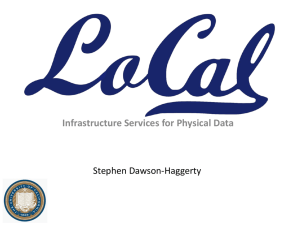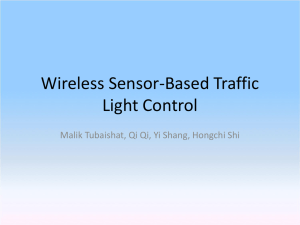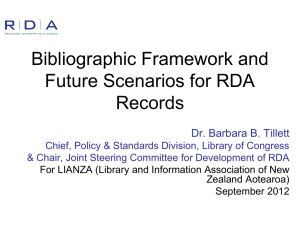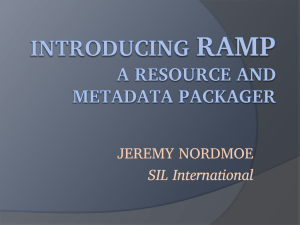JSI-Sensor-Middleware
advertisement
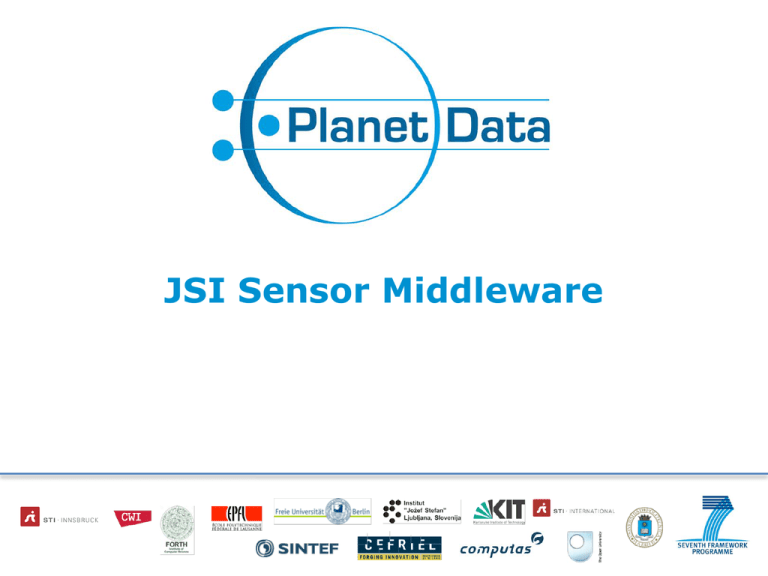
JSI Sensor Middleware
Embedded vs. Midleware based Architecture for
Sensor Metadata Management
•
Embedded approach
•
•
•
assign an IP address to every device
Sensors (things) are accessed directly from the
web without any intermediates
Middleware approach
•
involves using a gateway solution
•
•
•
applications communicate with a middleware that
intermediates to the things
•
•
interface with the applications
interface with a network of things
the middleware is responsible to collect metadata
from the things and respond to clients’ requests.
Depending on the two approaches, the
metadata can be stored, represented and
accessed in several ways.
•
More details in Metadata Management for the Web of
Things: a Practical Perspective, to appear in WoT 2012
- Third International Workshop on the Web of Things
Slide 2 of x
Sensor Metadata Storage
Embedded
•
•
•
metadata has been added •
to the embedded software
(firmware) of the devices
facilitates the automatic
•
gathering of information
about the sensors
stored in the flash
memory of the devices
Middleware
Relational Database
•
database schema reflects hardware
configuration
Knowledge base (triple stores)
•
Uses exiting ontologies for data
model
Metadata header
Module 1
Module 2
…
Module N
Metadata footer
Slide 3 of x
Sensor Metadata Representation
•
Structured representation of metadata following standardized
format
•
Solutions typically use a publicly shared schema, vocabulary or
ontology
•
•
most of them follow XML syntax
•
•
•
SensorML, ZigBee SmartEnergy, RDF (plus domain ontology – e.g. SSN)
Encoding techniques are needed for efficient storage and transmission from the embedded devices
Efficient XML Interchange (EXI), Binary XML (BXML), Binary JSON (BSON)
Embedded
structured representation of
metadata
•
•
disadvantage of occupying a
notable proportion of the
device’s memory resources,
it is required for integration
purposes
•
Middleware
Structured or custom
representation
•
•
Structured -> fast integration
with different storage systems
Custom -> good when there
are memory and energy
constraints; required
specialized parsers and
wrappers
Slide 4 of x
Sensor Metadata Representation
•
Implementations
•
•
•
Custom representation (a)
JSON-LD representation (b)
A sensor node that has two
types of sensors attached to
it, measuring temperature
and pressure in degree
Celsius and millibars
respectively
p01=403AB8F9&p02=VSCv1.2.1&p03=temperature
&p04=degC&p05=pressure&p06=mbar
(a)
"@context":{
"base":" http://hostname/semsense/resource/",
"uri": "@subject",
"isa" : "@type",
"sensorNode" : "http://purl.oclc.org/NET/ssnx/ssn#System",
"modules" : "http://purl.oclc.org/NET/ssnx/ssn#hasSubSystem",
...}
"uri":"base:403AB8FC",
"isa": "sensorNode",
"modules" : [ {
"uri":"base:403AB8FC/s1",
"isa": "sensor",
"observedProperty" : {
"uri" : "temperature",
"uom" : "degC",
}
},
{
"uri":"base:403AB8FC/s2",
"isa": "sensor",
"observedProperty" : {
"uri" : "pressure",
"uom" : "mbar",
}
}]
(b)
Slide 5 of x
Sensor Metadata Representation
• Semantic Vocabulary
•
SSN ontology
•
Result of W3C Semantic Sensor Network Incubator Group
• Other Vocabularies/Ontologies: Basic GeoWGS84,
GeoNames, Measurement Units Ontology
• Subset of concepts and relationships from SSN
Slide 6 of x
Sensor Metadata Access
Embedded
•
a RESTful API to the resource
containing metadata which returns a
structured JSON-LD message
•
•
The application which generated the
call can parse the message using a
JSON-LD processor
metadata access on the node is done
through the resource and not by
querying the sensor node URI
Middleware
•
SPARQL end-points of the triple
stores
•
•
Relational Database combined with
D2R server
Triple store -> Sesame
Slide 7 of x
Conclusions
•
Both the embedded and the middleware solutions can be
prototyped
•
The current state of the art in sensor devices limits the
amount of stored data
• XML like syntax is not well suited for storing.
• constraints are imposed by the communication links.
•
The middleware approach is more convenient from the
perspective of web application developer
•
technological developments empowering the embedded
approach may be catching up soon.
Slide 8 of x





